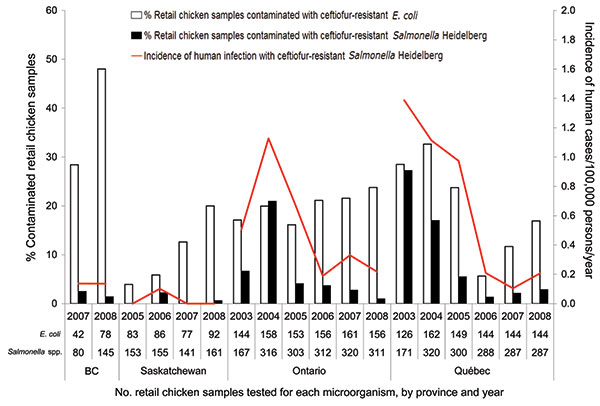Ceftiofur Resistance in Salmonella enterica Serovar Heidelberg from Chicken Meat and Humans, Canada
Lucie Dutil

, Rebecca J. Irwin, Rita Finley, Lai King Ng, Brent P. Avery, Patrick Boerlin, Anne-Marie Bourgault, Linda Cole, Danielle Daignault, Andrea Desruisseau, Walter Demczuk, Linda Hoang, Greg B. Horsman, Johanne Ismail, Frances B. Jamieson, Anne Maki, Ana Pacagnella, and Dylan R. Pillai
Author affiliations: Public Health Agency of Canada, Saint-Hyacinthe, Québec, Canada (L. Dutil, D. Daignault); Public Health Agency of Canada, Guelph, Ontario, Canada (R. Irwin, R. Finley, B. Avery, L. Cole, A. Desruisseau); Public Health Agency of Canada, Winnipeg, Manitoba, Canada (L.K. Ng, W. Demczuk); Ontario Veterinary College, Guelph (P. Boerlin); Institut National de Santé Publique du Québec, Sainte-Anne-de-Bellevue, Québec, Canada (A.-M. Bourgault, J. Ismail); British Columbia Centre for Disease Control, Vancouver, British Columbia, Canada (L. Hoang, A. Pacagnella); Saskatchewan Disease Control Laboratory, Regina, Saskatchewan, Canada (G. Horsman); Ontario Agency for Health Protection and Promotion, Toronto, Ontario, Canada (F. Jamieson, A. Maki, D.R. Pillai)
Main Article
Figure 1

Figure 1. Prevalence of retail chicken contaminated with ceftiofur-resistant Escherichia coli and Salmonella enterica serovar Heidelberg and incidence of human infections from ceftiofur-resistant Salmonella Heidelberg in Canada.
Main Article
Page created: March 31, 2011
Page updated: March 31, 2011
Page reviewed: March 31, 2011
The conclusions, findings, and opinions expressed by authors contributing to this journal do not necessarily reflect the official position of the U.S. Department of Health and Human Services, the Public Health Service, the Centers for Disease Control and Prevention, or the authors' affiliated institutions. Use of trade names is for identification only and does not imply endorsement by any of the groups named above.
